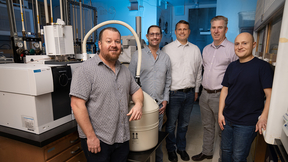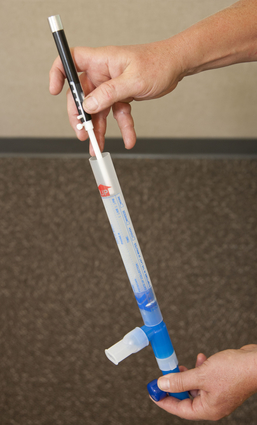Breath analysis workshop set for biomedicine and national security
The Laboratory, in collaboration with the University of California, Davis and the Canterbury Respiratory Research Group, will host the 2012 International Breath Analysis Meeting, Oct. 28-Nov. 1 at the Fairmont Sonoma Mission Inn in Sonoma, Calif.
The event, titled "Breath Analysis for Biomedicine and National Security: Sensor Design Issues and Strategies for Biomarker Discovery," will address the technological advances in human breath analysis and diagnostics, along with associated data analysis methods and collection protocols.
"We envision that this workshop will provide an opportunity for participants to discuss their own projects, debate future directions of the field, and contemplate areas of research that deserve special attention in the field moving forward," says Matthias Frank, a co-chair of the event and a physicist in LLNL's Physical & Life Sciences Directorate. "This event will facilitate engagement with industry to shed light on near-term research trends that can yield the next generation of breath analysis sensor platforms.
"What we're trying to do is to bring together doctors who use breath analysis in clinics with physicists, chemists, engineers and computer scientists who develop new sensors and algorithms that are potentially applicable to breath analysis in the future," Frank added.
Another Laboratory employee, Amy Gryshuk, who holds her Ph.D. in molecular pharmacology and is a member of the Biosciences and Biotechnology Division, also is a co-chair of the breath analysis workshop.
Most of today's breath instruments are bulky and relatively slow, Frank said, indicating that many researchers would like to bring the latest advances in trace gas analysis and microfluidics to the field.
The 2012 International Breath Analysis Meeting will provide an opportunity for researchers from academia, medicine, industry and the national laboratories to discuss important topics associated with breath sensor instrumentation and applications of breath analysis.
Participants will explore potential future collaborations, and teaming opportunities for competitive grant proposal submissions to federal funding agencies. Interactions with industry will shed light on near-term research trends that can yield the next generation of breath analysis sensor platforms.
About 150 researchers are expected to attend the fall conference, including U.S. researchers from the Cleveland Clinic, Menssana Research Inc. and the Johns Hopkins/Bloomberg School of Public Health. Significant participation also is anticipated from overseas, including Germany, Italy, Japan and New Zealand.
The upcoming conference follows three West Coast meetings held at U.C. Davis and Menlo Park-based SRI over the past four years that were organized by LLNL, U.C. Davis and SRI.
In one previous project for the U.S. Department of Defense, LLNL researchers have explored the use of breath analysis for counterterrorism applications, including the detection of chemicals and explosives.
Most recently, LLNL researchers have started to develop concepts for a miniaturized breath analysis system.
"For many years, the U.S. Environmental Protection Agency has investigated the use of breath analysis to detect the exposure of workers to chemicals, such as solvents," Frank said. "We are extending this approach and are investigating the use of breath analysis to detect exposure of people to bioterrorist and chemical warfare agents."
Breath analysis is an emerging field, which seeks to test for specific health markers through the non-invasive analysis of exhaled human breath. It has applications in almost every scientific field, especially in medical diagnostics, national security and forensics.
As human breath analysis further develops as a multi-disciplinary field, it is believed that sensor development, instrumentation systems and algorithms will play critical roles within this research area. Although much emphasis in the last decade has focused on breath biomarker compound identification and physiological relevance, researchers have increasingly turned their attention toward portable sensor platforms for non-invasive breath monitoring.
For more information, go to the UC Davis Breath Analysis Website.
Contact
Stephen P Wampler[email protected]
925-423-3107
Tags
Global SecurityStrategic Deterrence
Featured Articles









